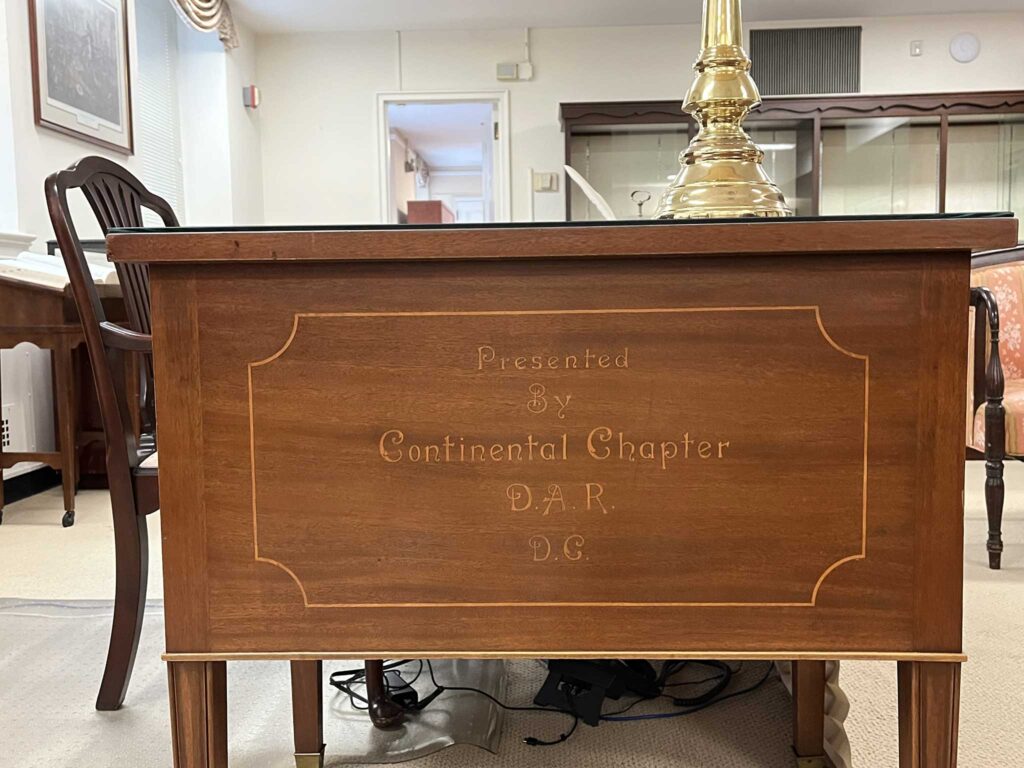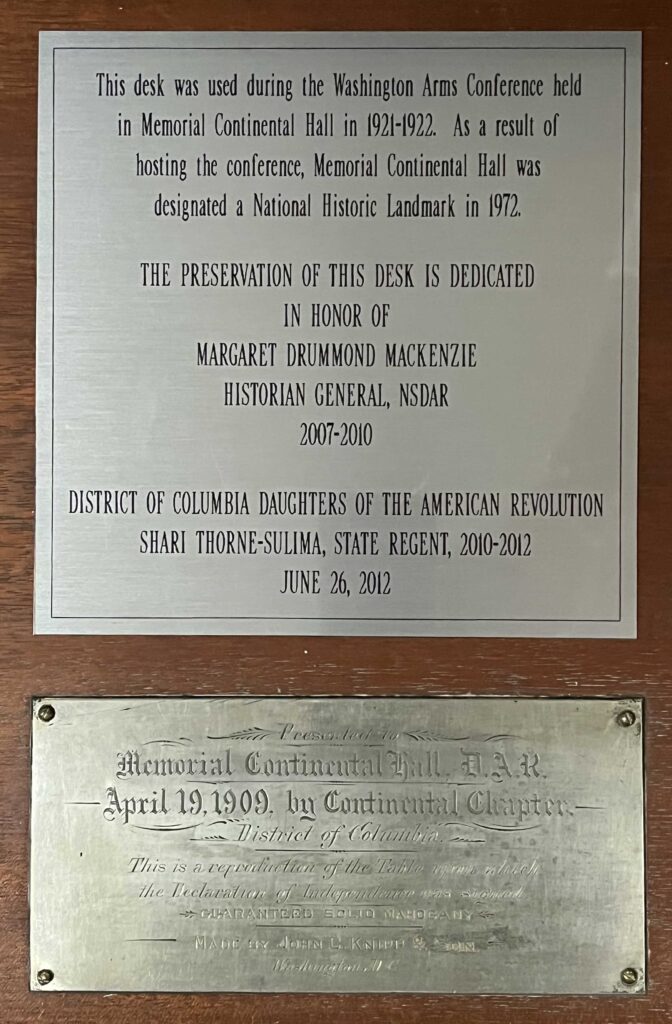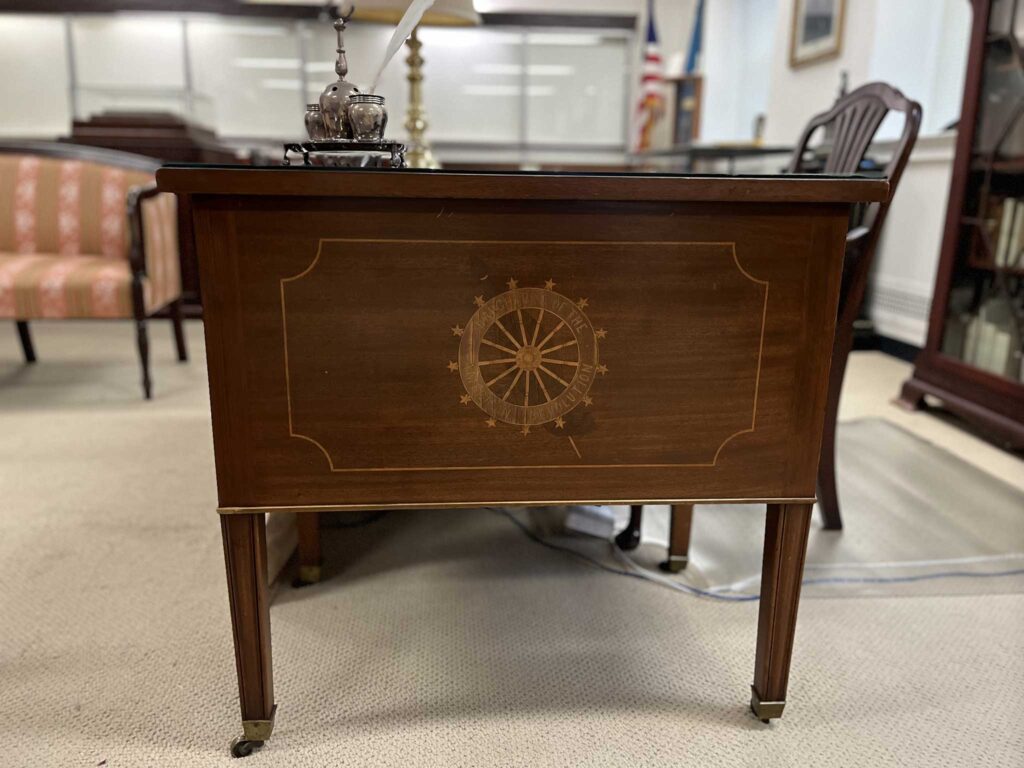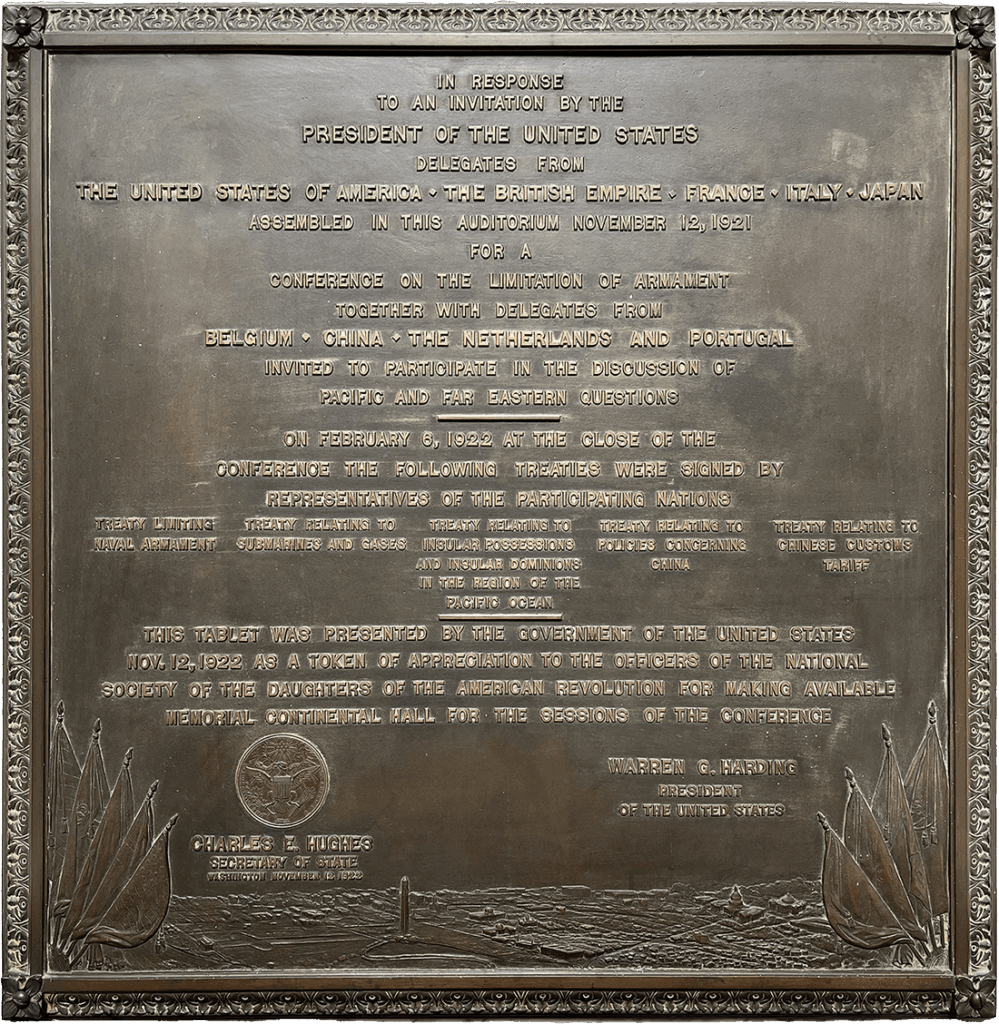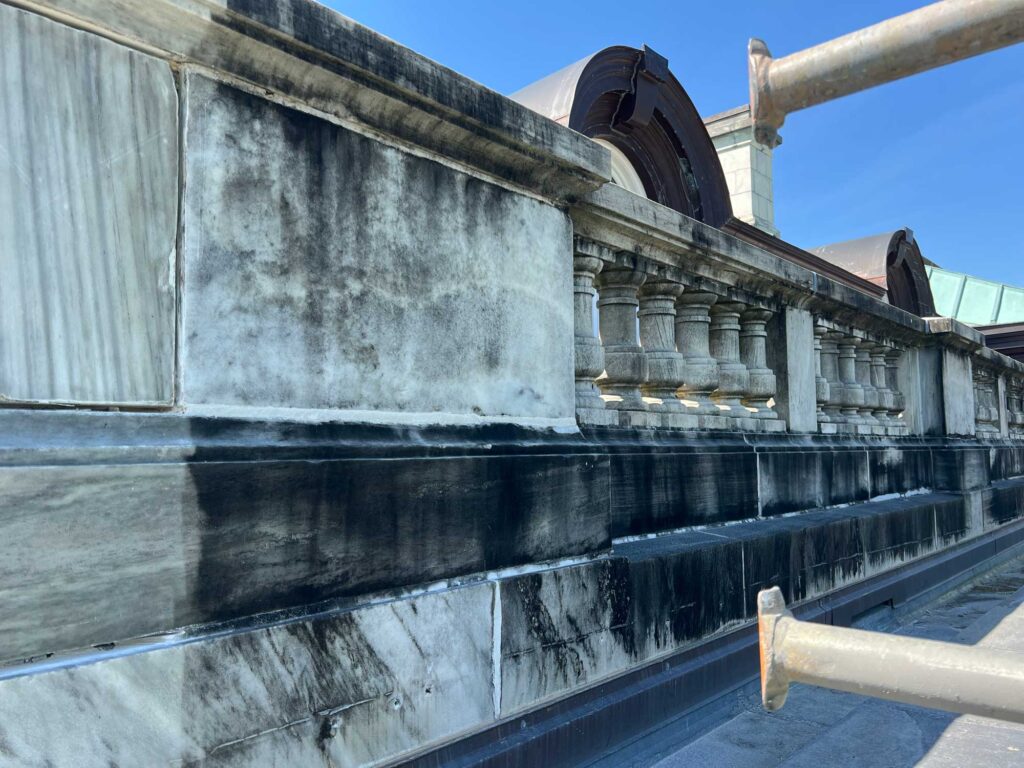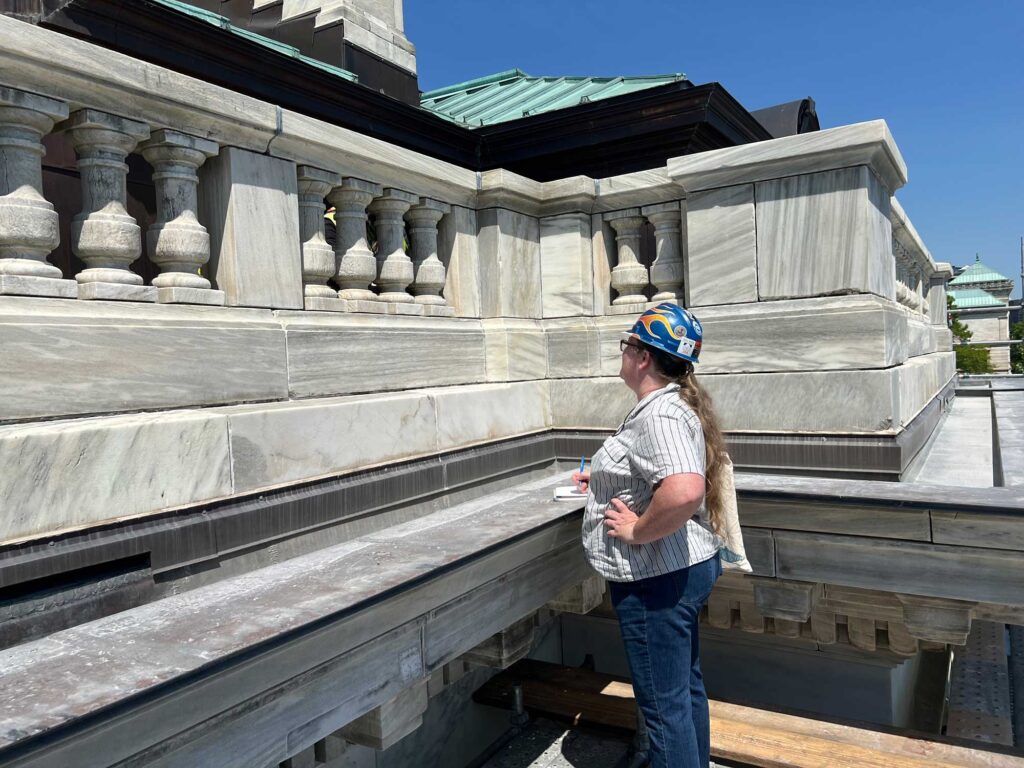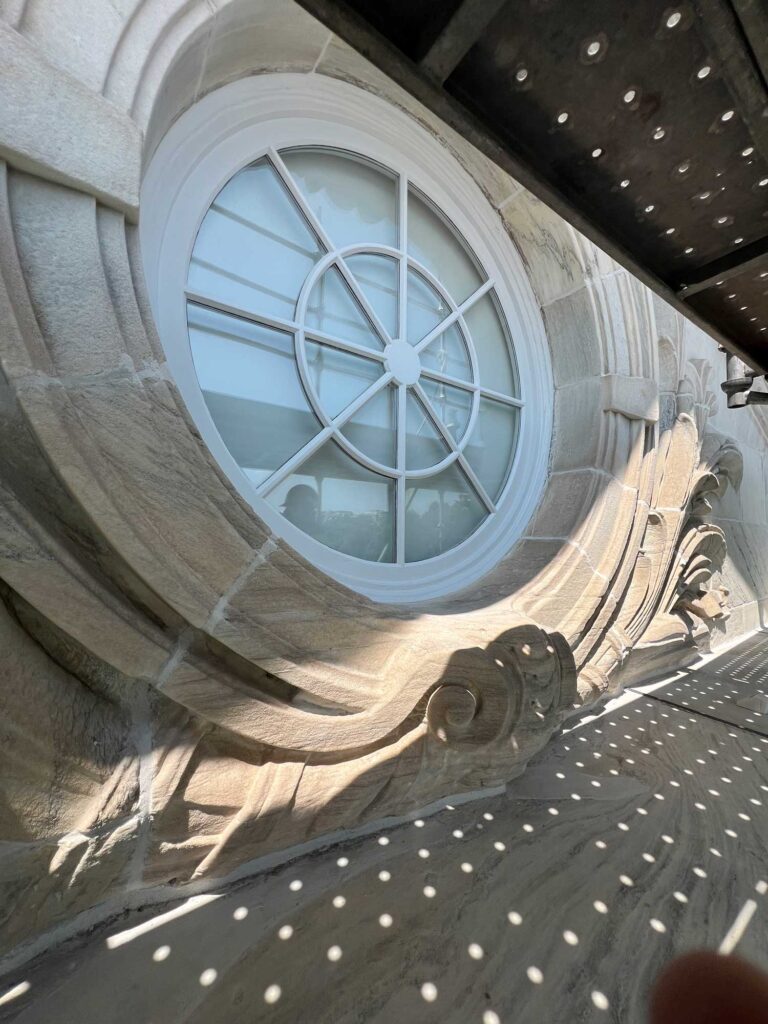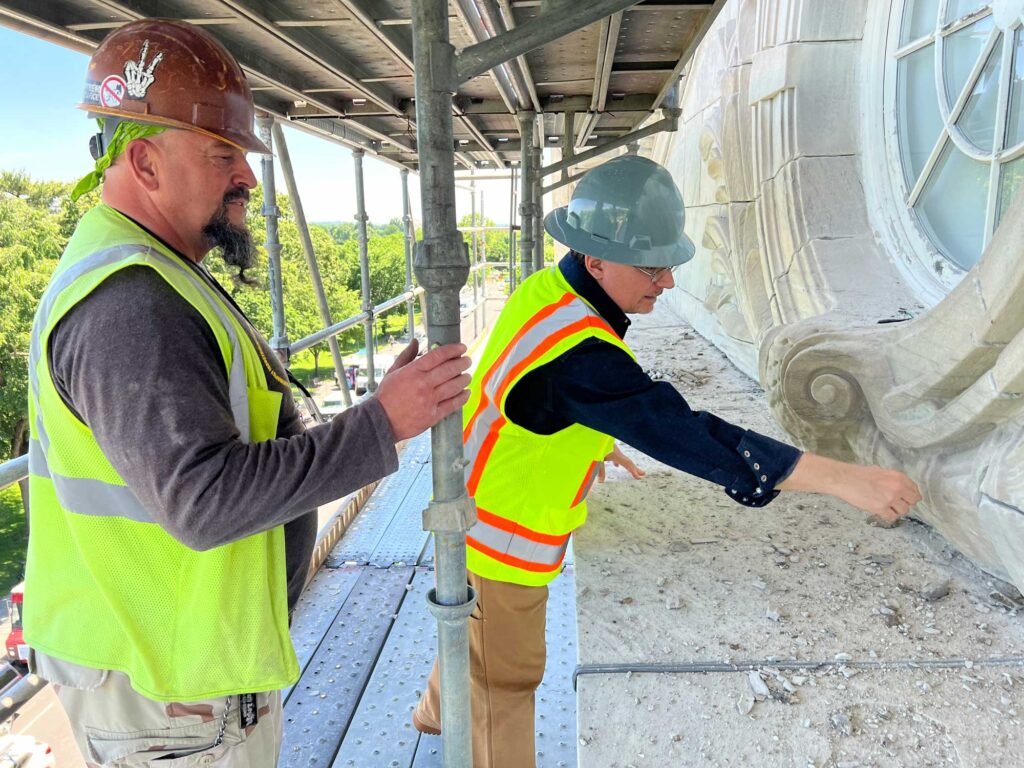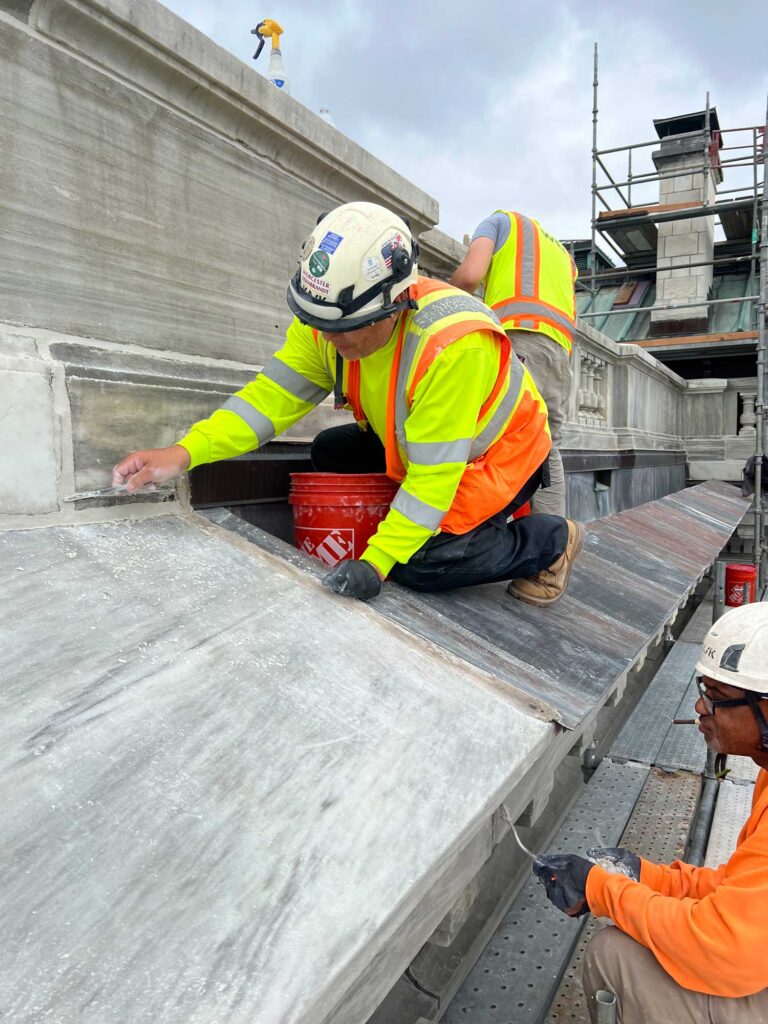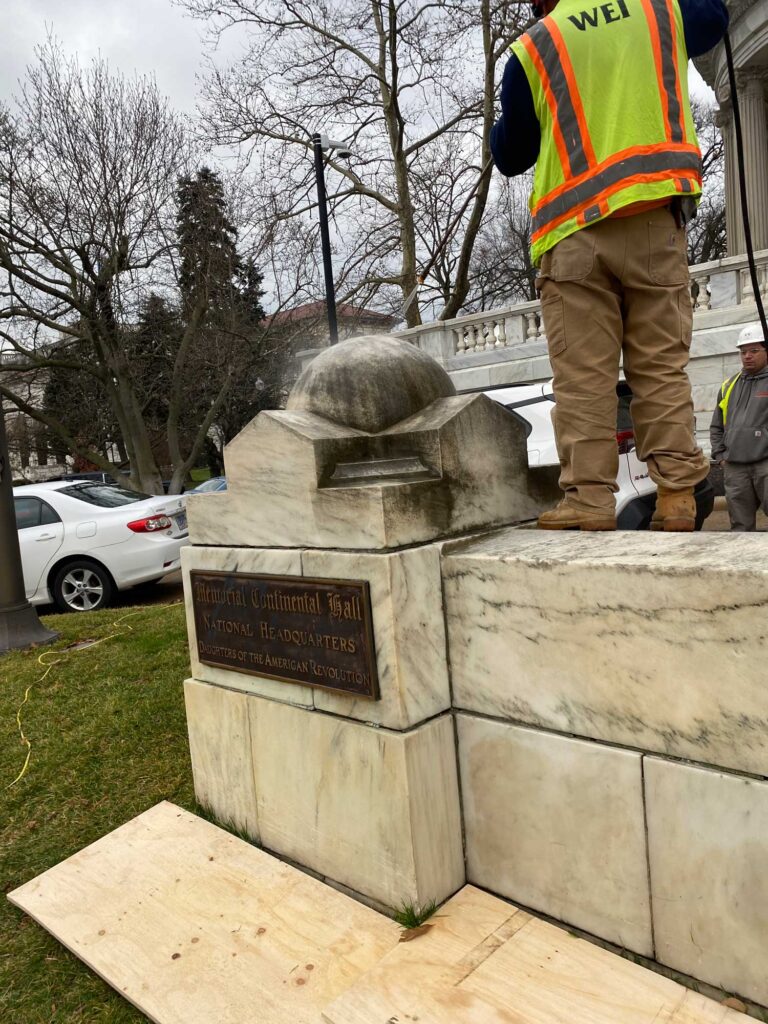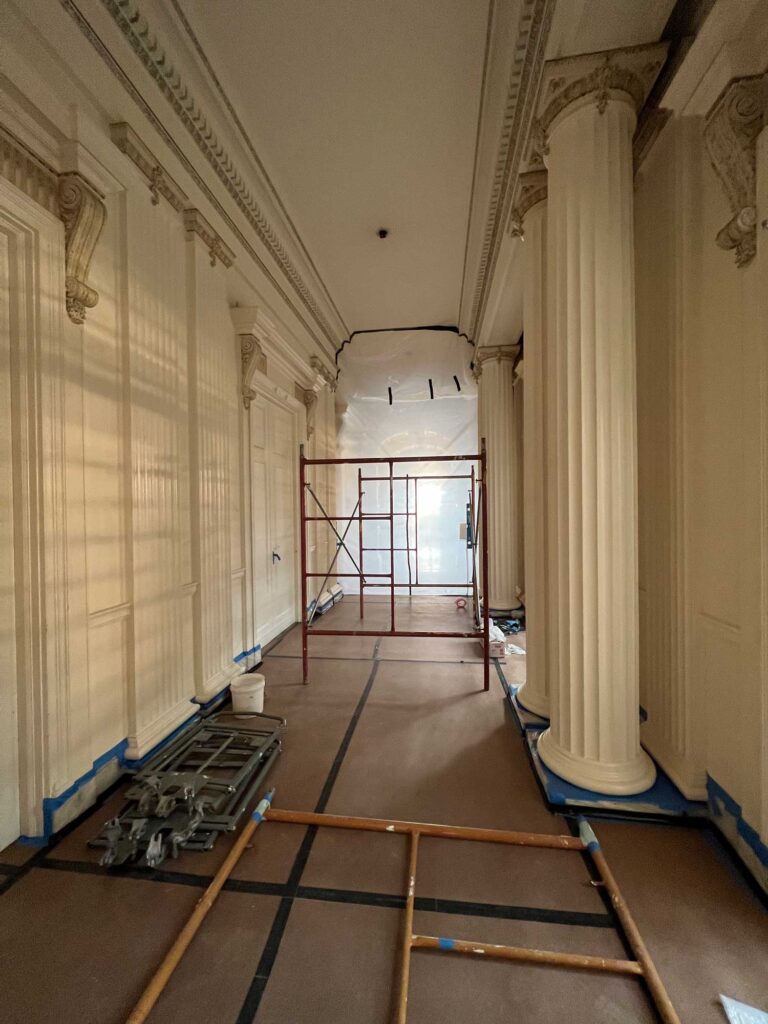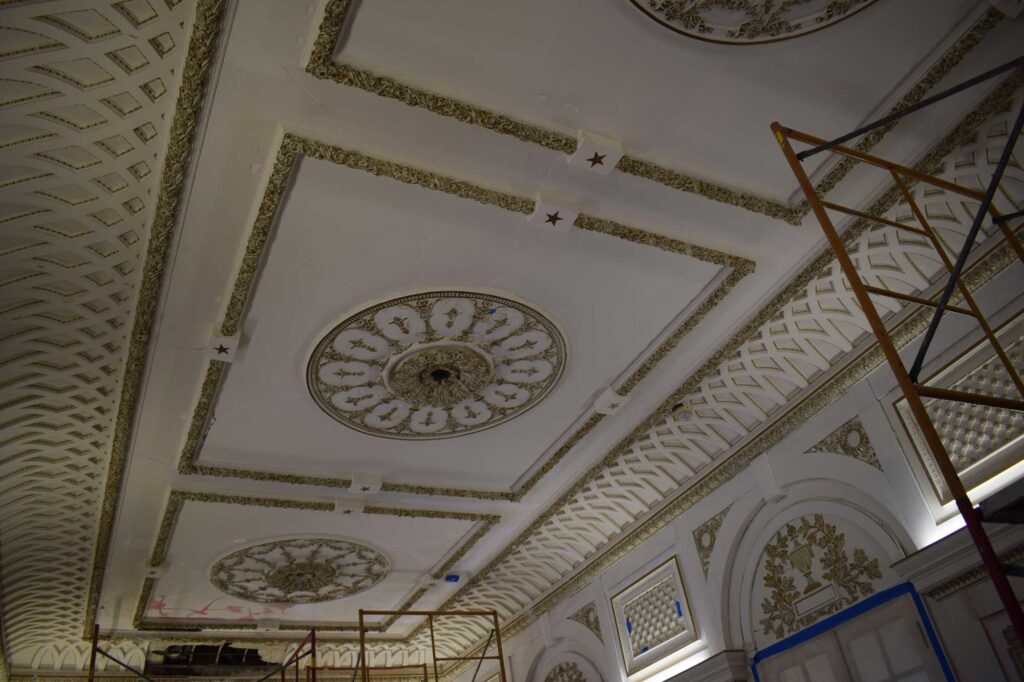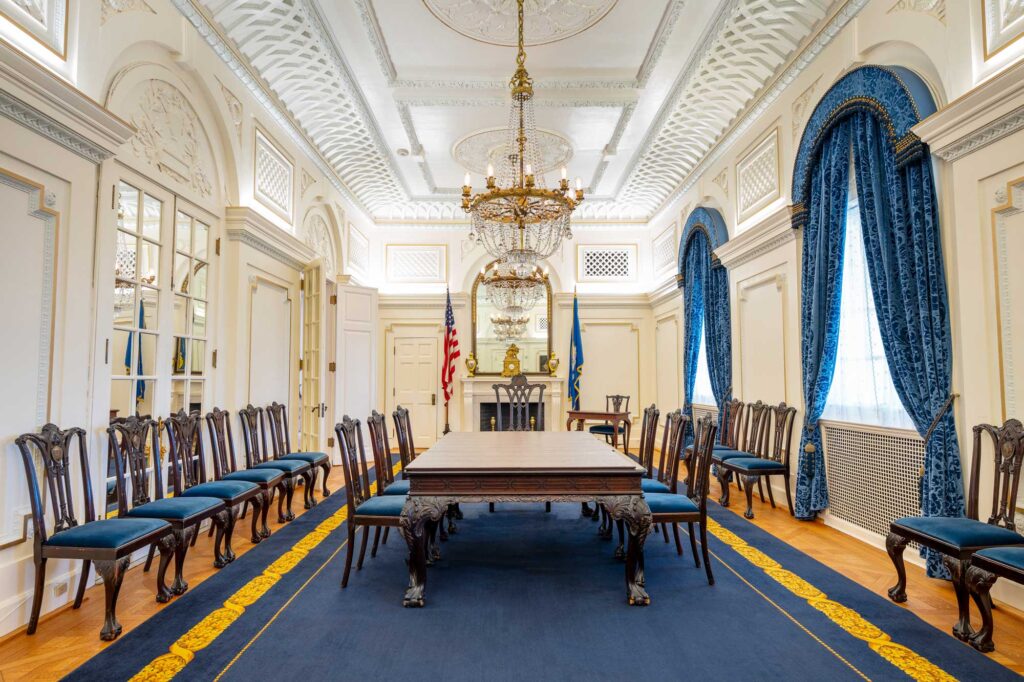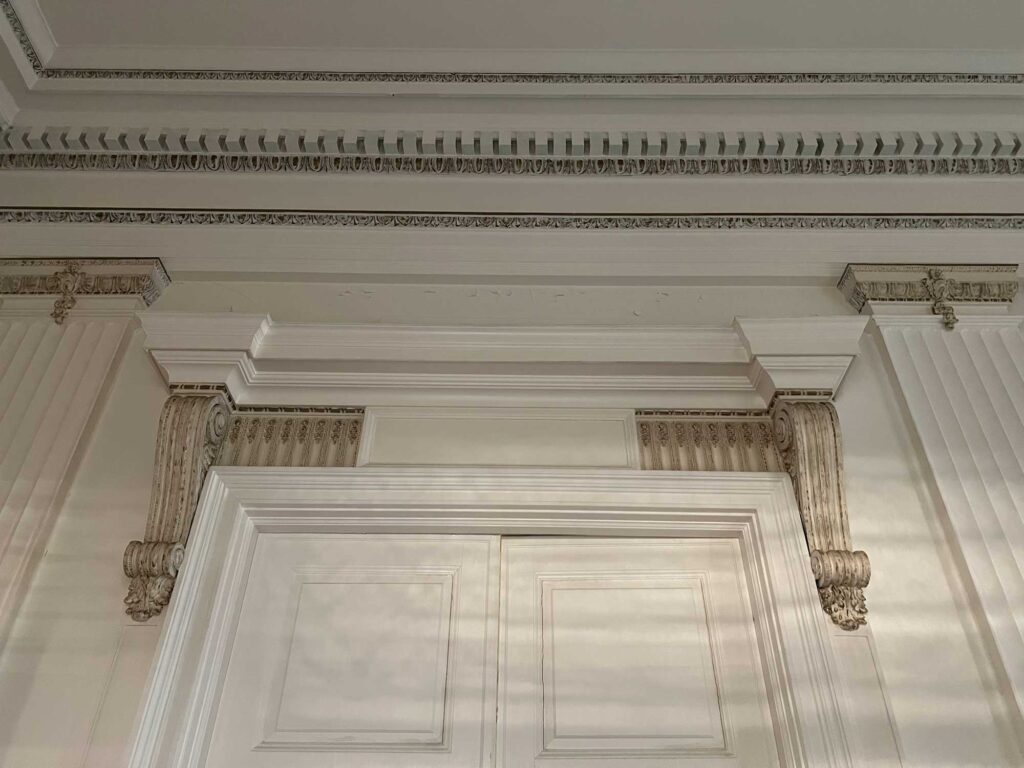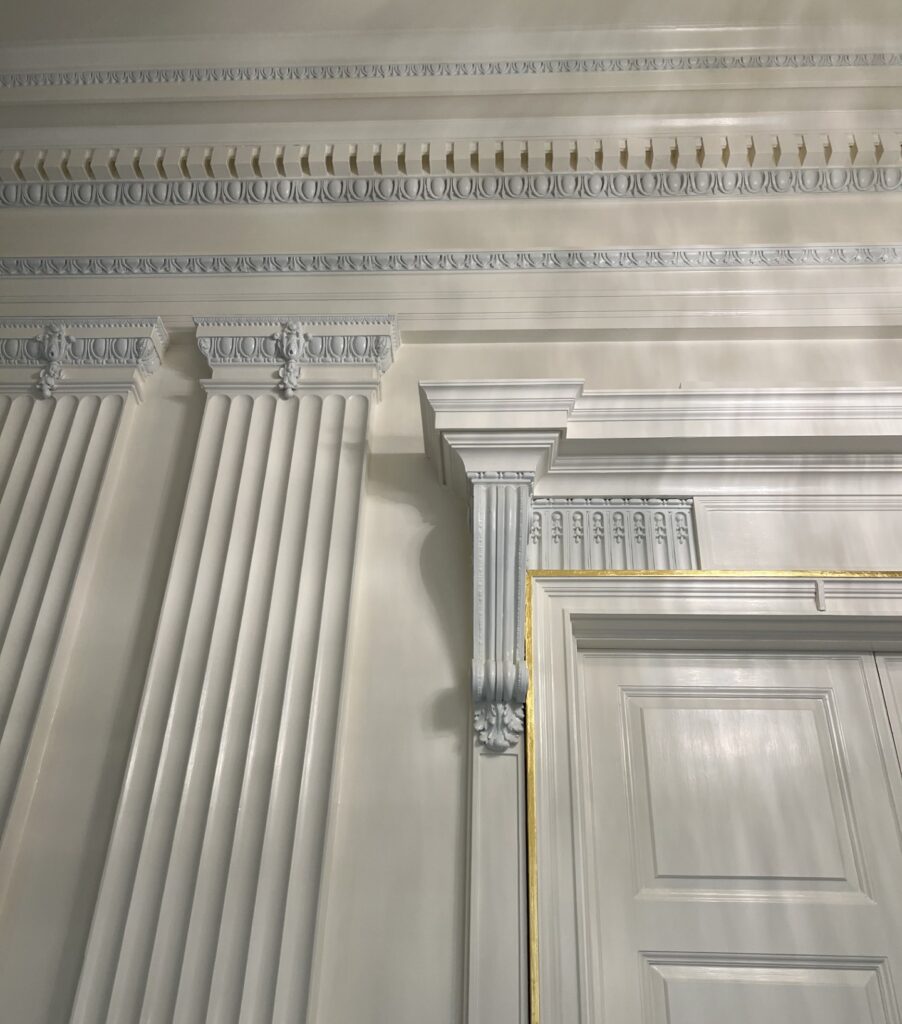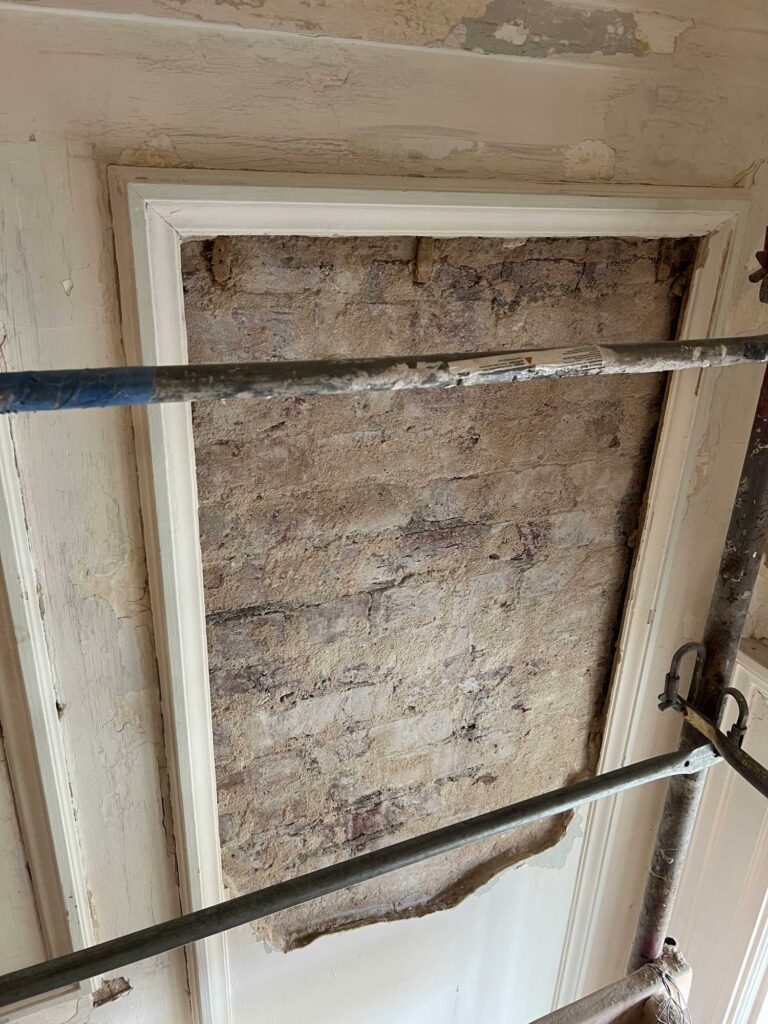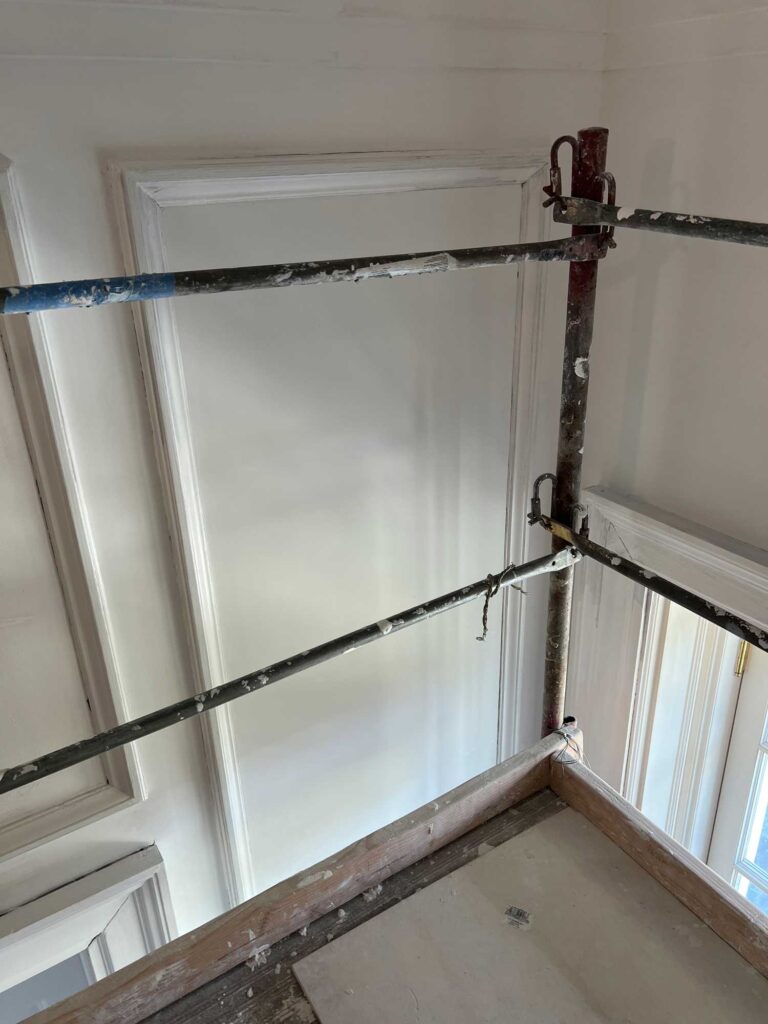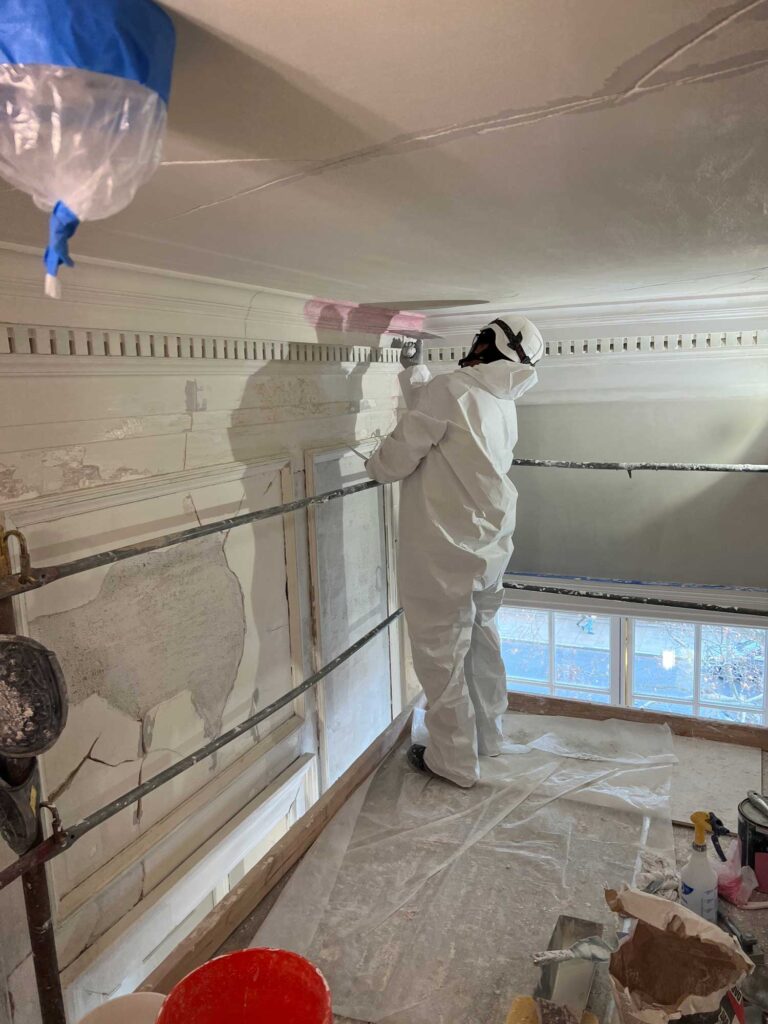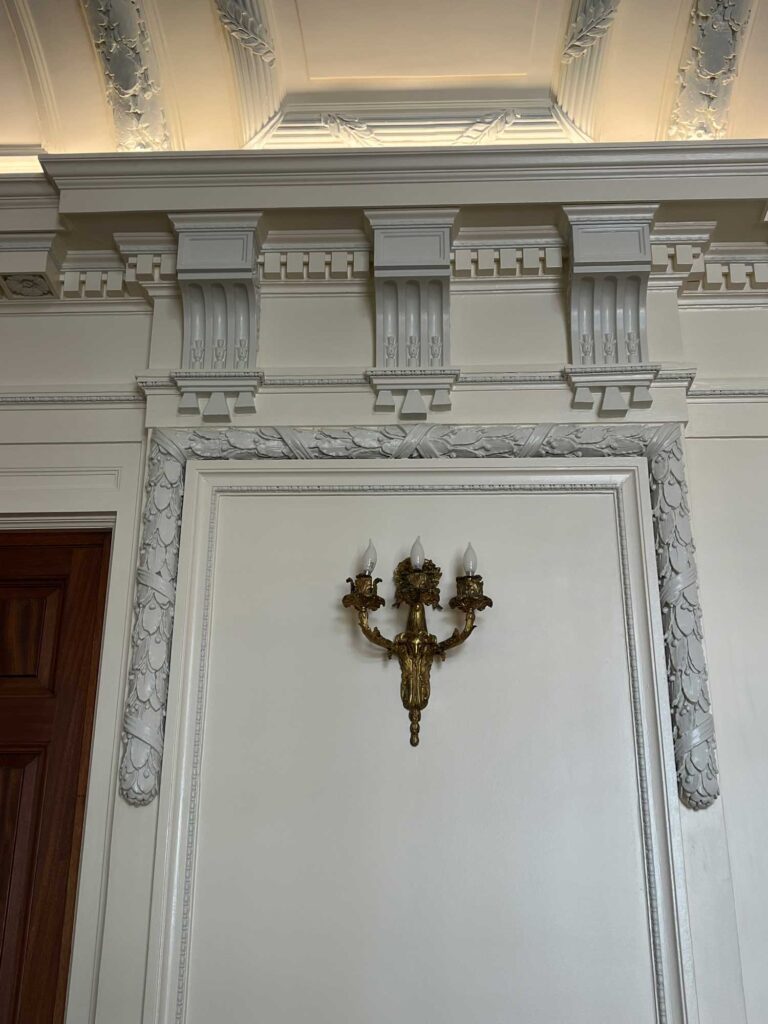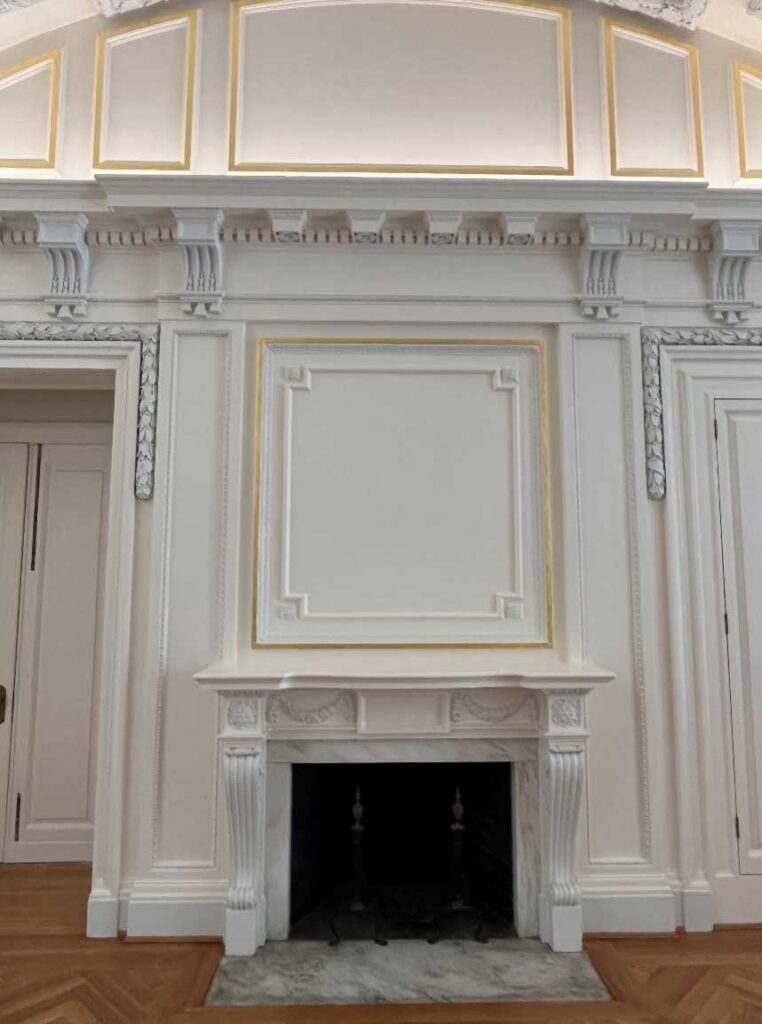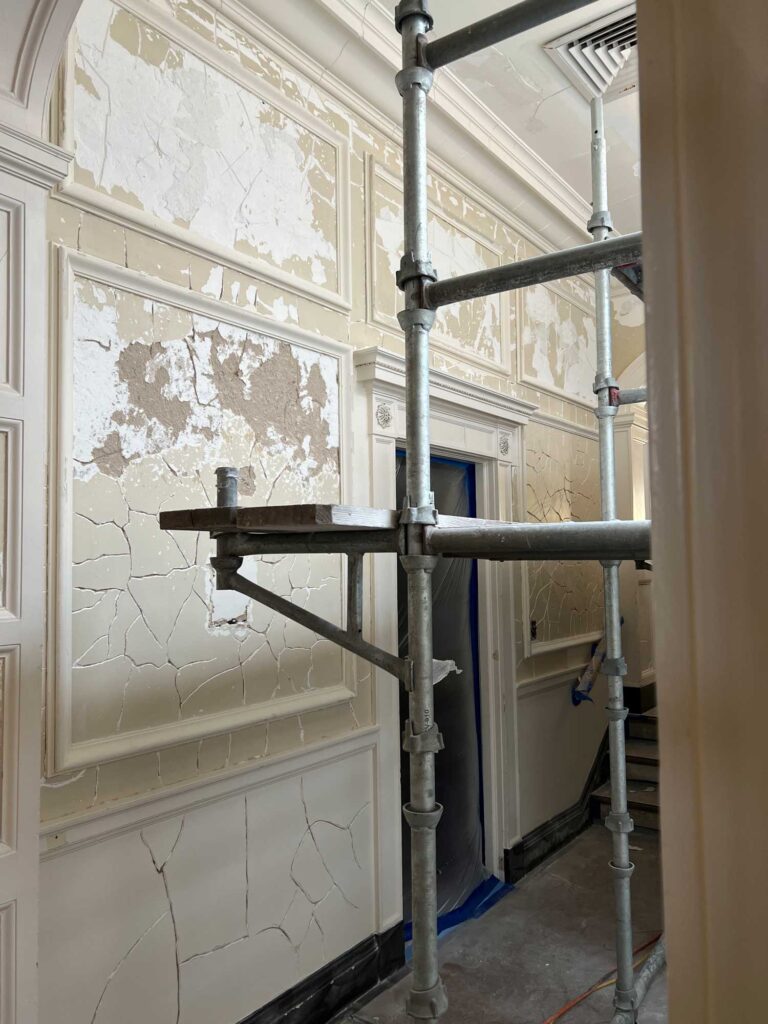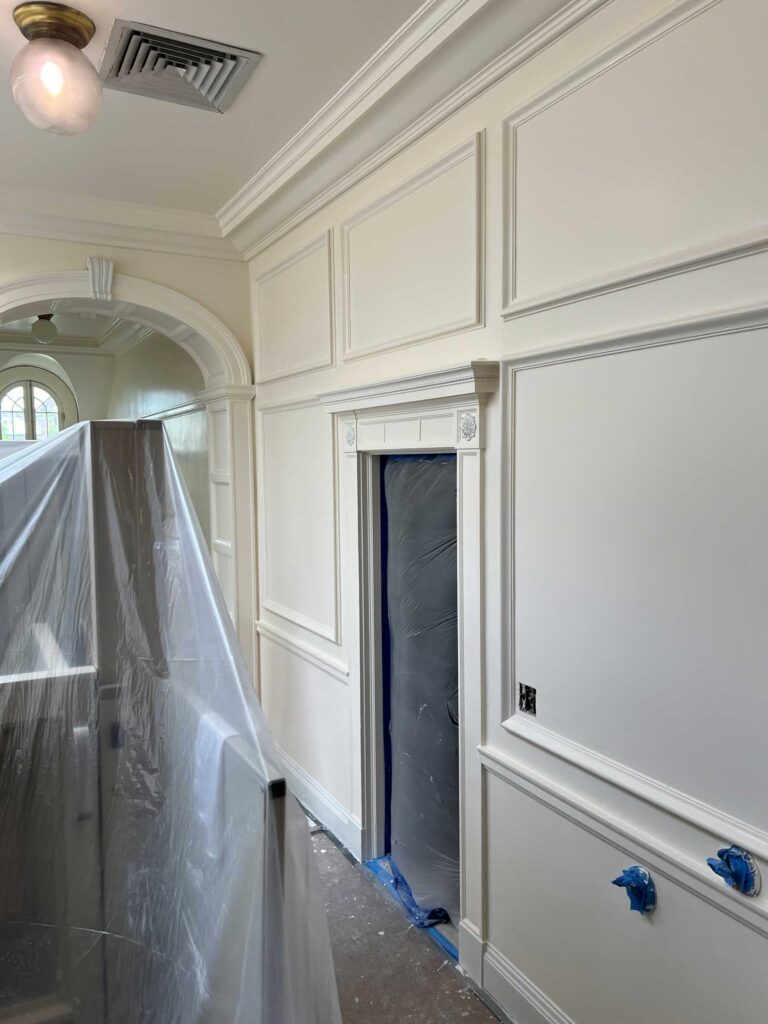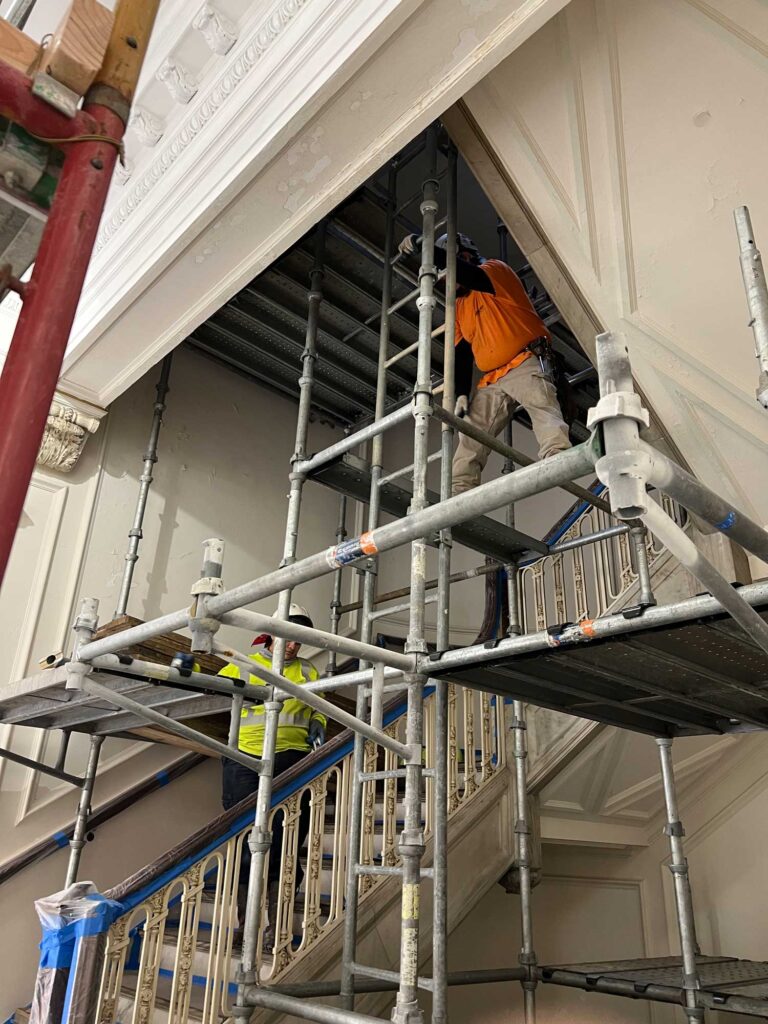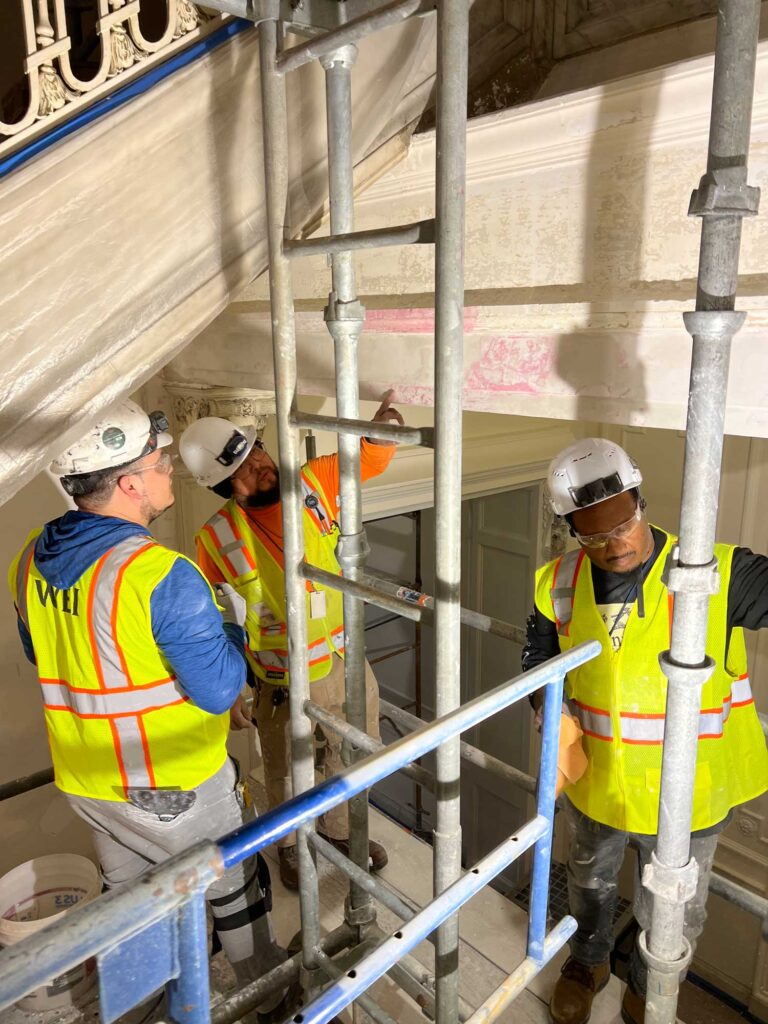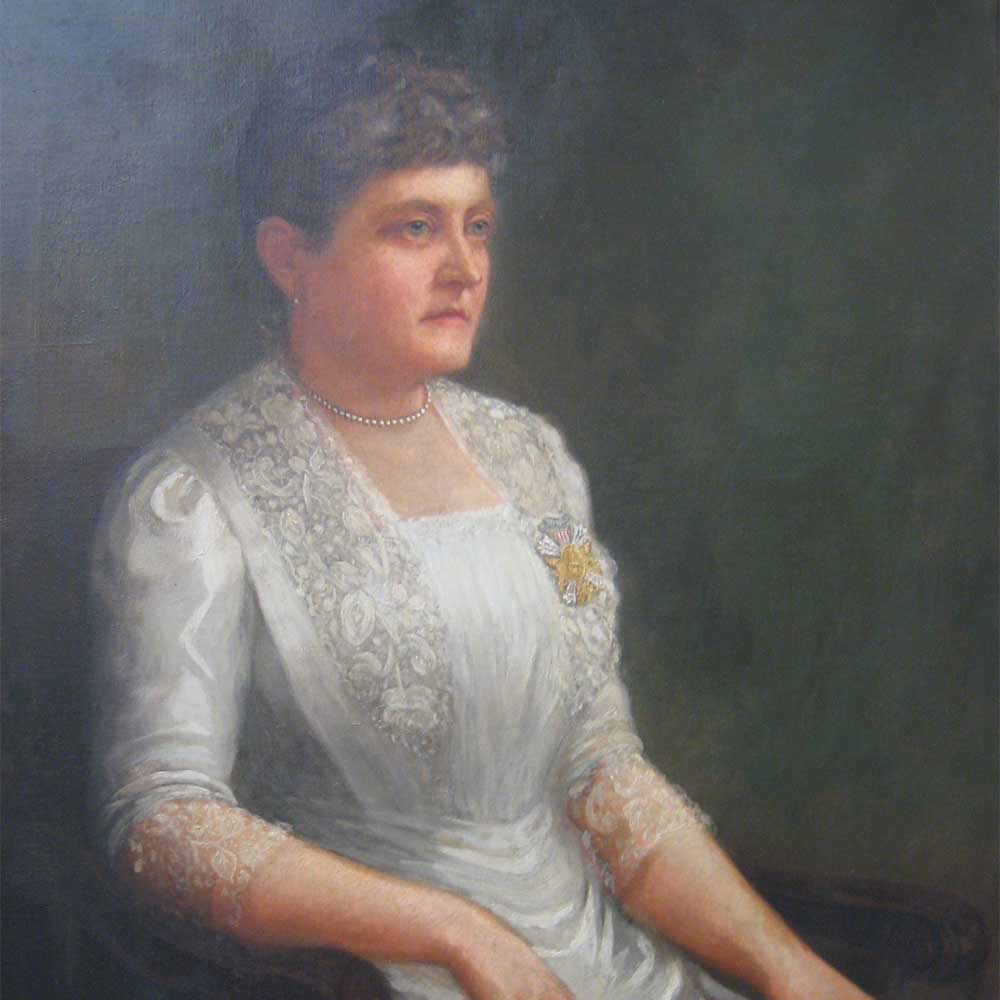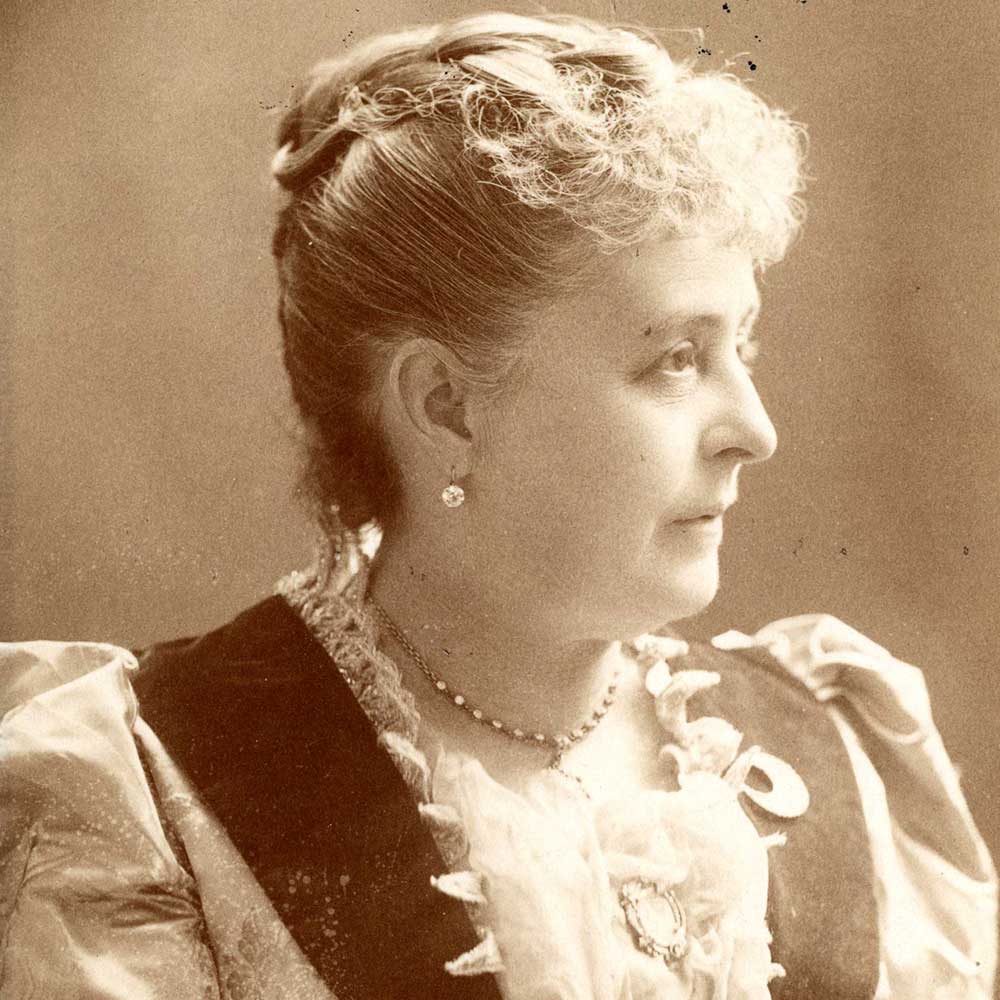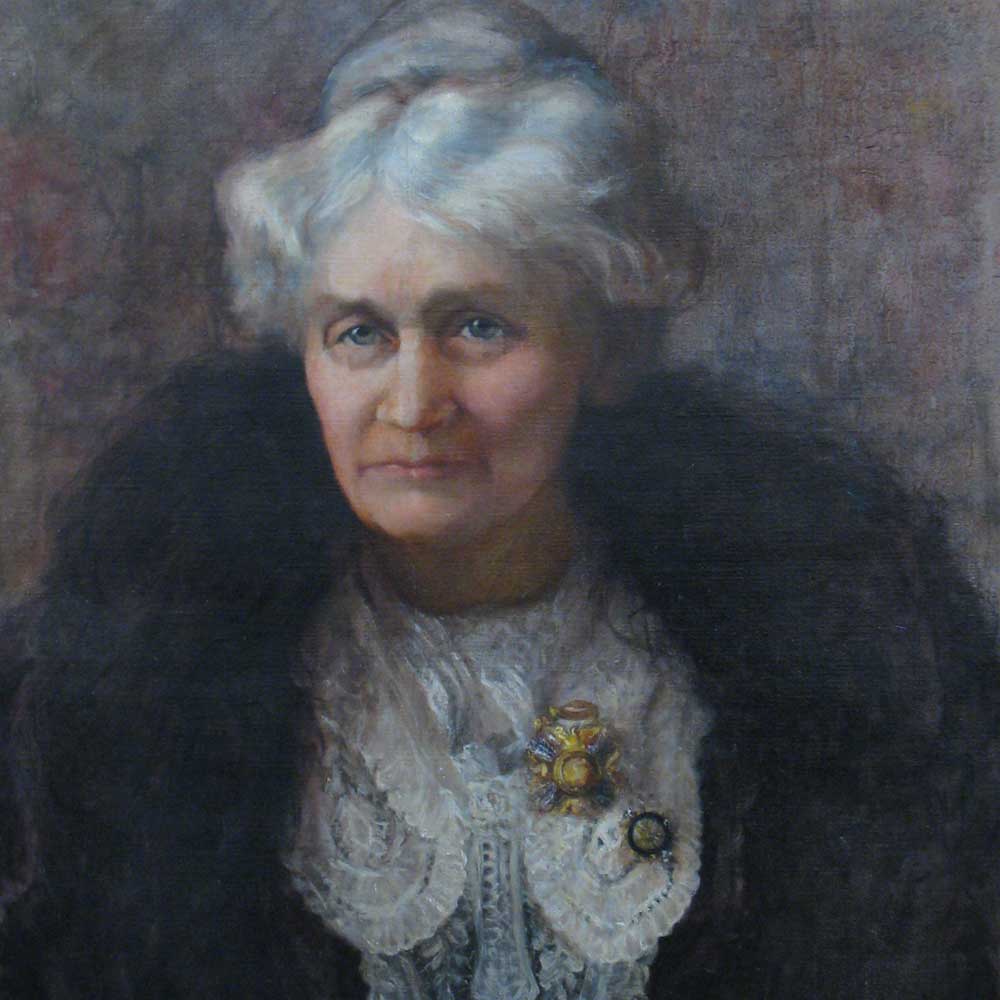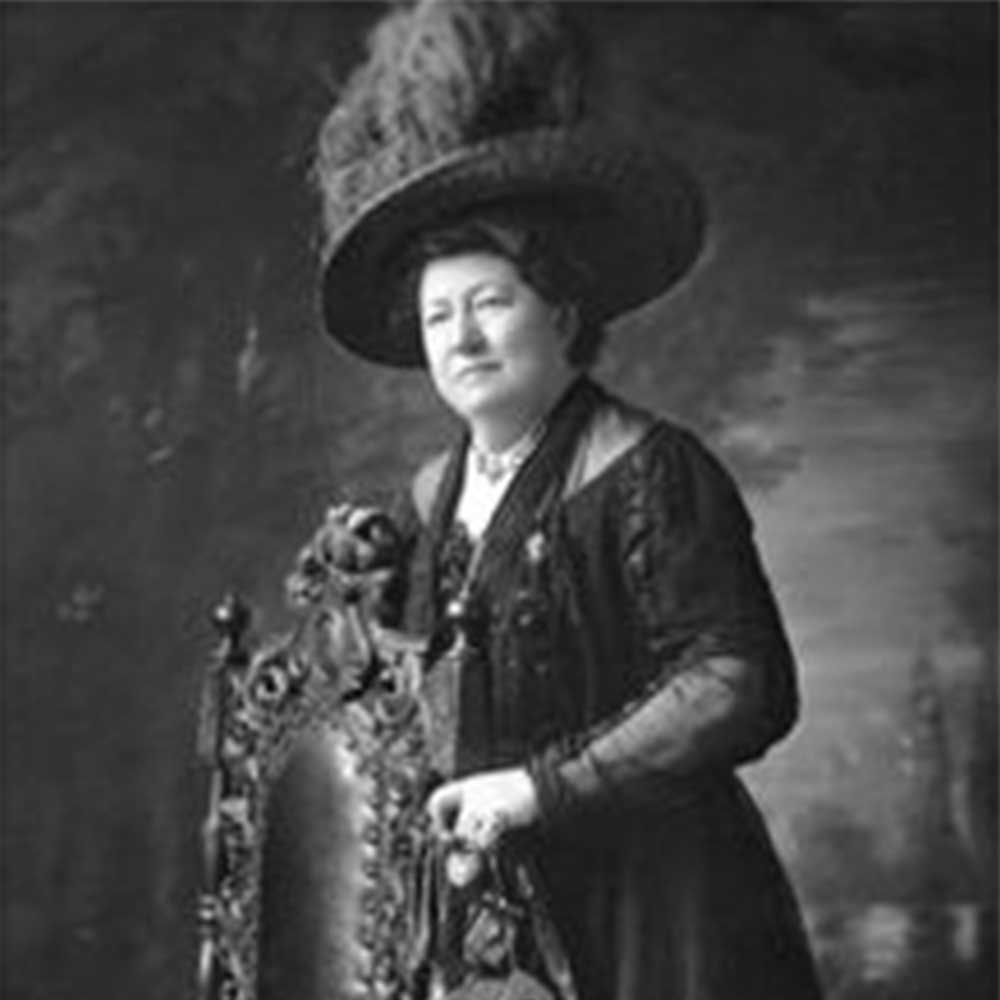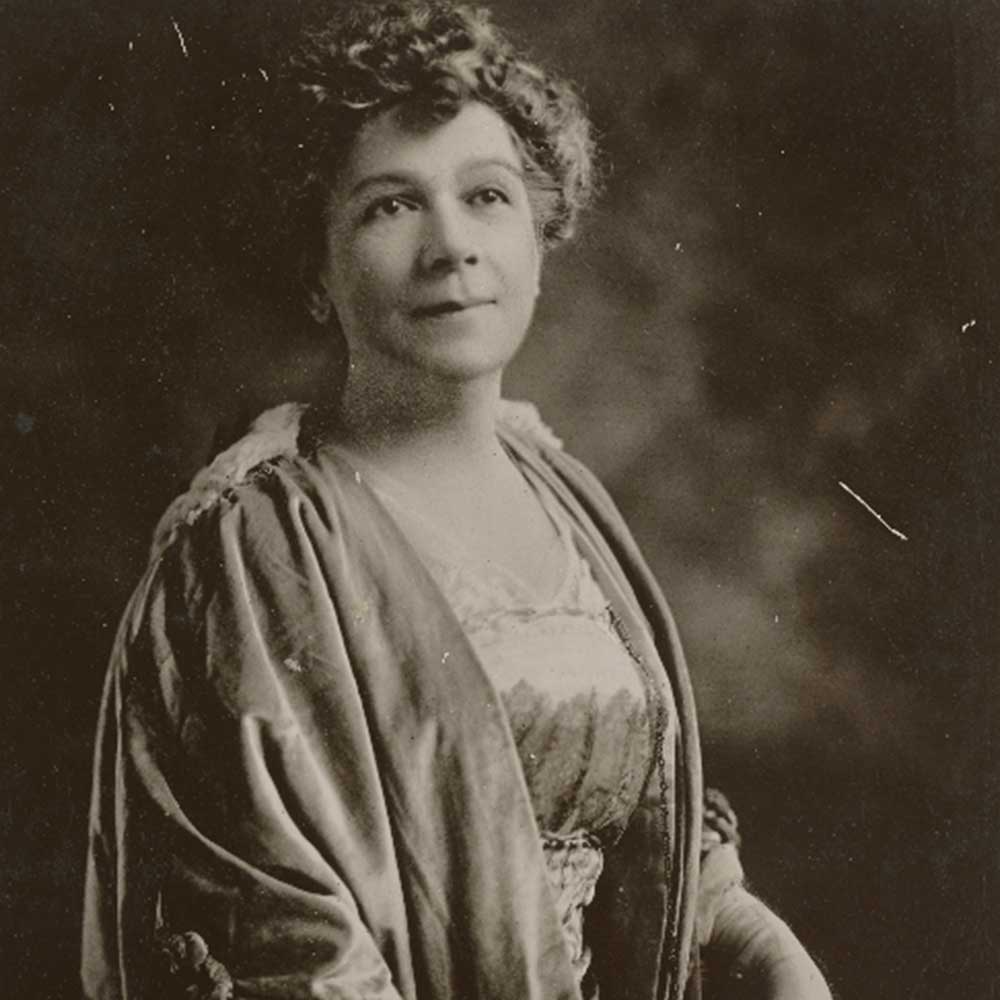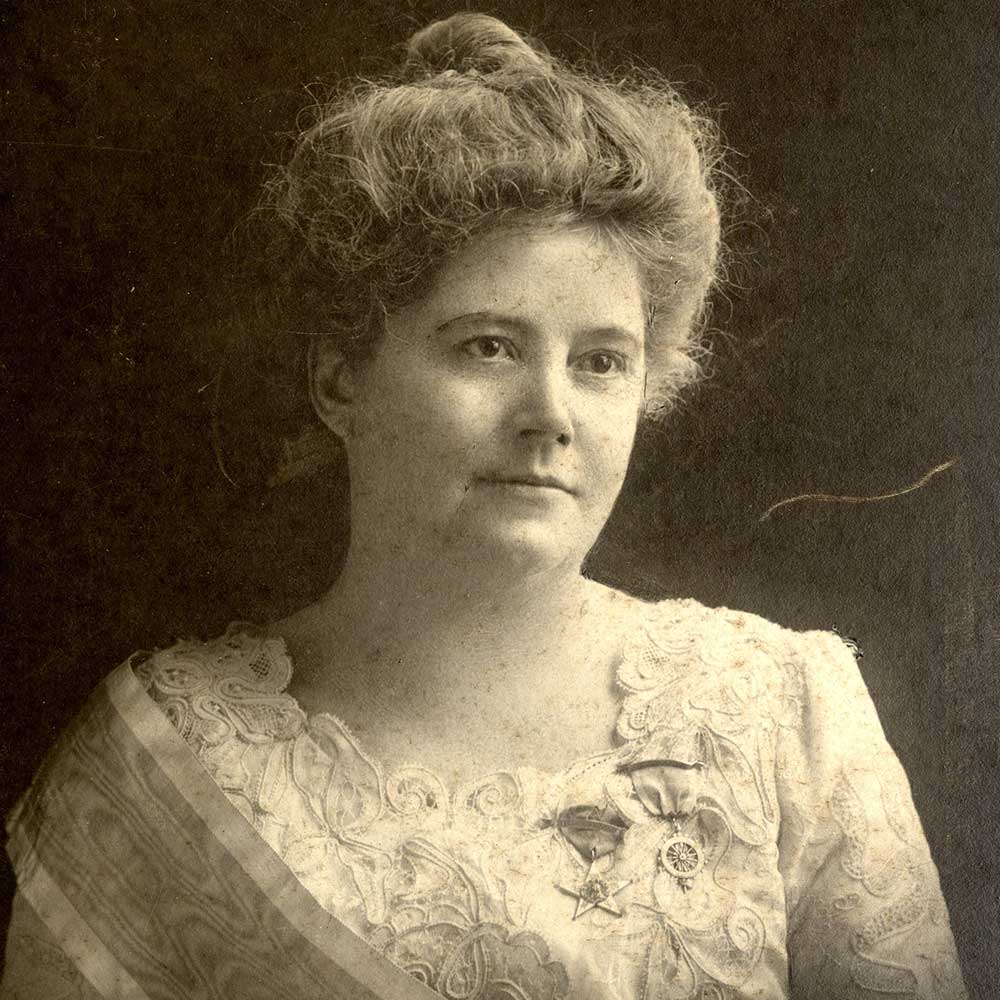Restoration
The restoration of Memorial Continental Hall began as a discussion between President General Pamela Rouse Wright, First Vice President General Ginnie Sebastian Storage, and Patrick Sheary, DAR Curator of Furnishings and Historic Preservation. As a national treasure honoring the men and women who sacrificed to found this nation, Memorial Continental Hall’s preservation is paramount. In adherence to the Society’s Act of Incorporation, Daughters continuously strive to safeguard and maintain elements of historical, educational, and patriotic significance.
Designated in 1972, as a Registered National Historic Landmark, Memorial Continental Hall has played a vital role throughout history. It hosted the renowned Washington Naval Conference, aka the Conference on the Limitation of Armaments (1921–1922), provided training space during World War II, and DAR Daughters efforts raised over $200 million to benefit military families. Today, it houses a world-class library containing invaluable society resources, authentic records, and an extensive collection of books, maps, and specialized research materials—all within its former auditorium.
This desk was used during the Washington Arms Conference held in Memorial Continental Hall in 1921-1922. The desk was present to the National Society by Continental Chapter, District of Columbia, April 9, 1909. It is a mahogany reproduction of the Table upon which the Declaration of Independence was signed.

Video Series – A Closer Look at Memorial Continental Hall
After years of neglect, the building’s restoration was chosen as the President General’s flagship project, with work undertaken on both the exterior and interior simultaneously. The Vermont marble façade had accumulated layers of black soot, suffered leaks due to missing mortar joints and poor repairs, and endured damage from acid rain, requiring careful stabilization and repair.
Inside, Mrs. Wright envisioned a restoration that would return Memorial Continental Hall as closely as possible to its original 1910 appearance.
To achieve this vision, the National Society partnered with Worcester Eisenbrandt, Inc. (WEI), a nationally recognized restoration contractor based in Baltimore, Maryland. Having successfully completed previous restoration projects for us, WEI’s familiarity with the building and consistent high-quality work made them the ideal choice for this endeavor.
Before the restoration could begin, architectural conservator Amy Hollis surveyed the entire façade of Memorial Continental Hall. In architecture, the façade of a building is often the most important aspect from a design standpoint, as it sets the tone for the rest of the building. From the engineering perspective, the façade is also of great importance due to its impact on energy efficiency. This work took many months, and all repairs were charted electronically. Here, Amy refers to the survey on an iPad.
A pediment is a triangular gable wall that imitates the style and construction of Classical Greek temple pediments. Thus, they may be placed over columns and an entablature (horizontal moldings resting on columns) or extend out from the wall to be supported by columns.
A balustrade is a row of small, evenly spaced vertical columns (balusters) topped by a railing (banister). The balusters connect to form a balustrade that holds up the railing or banister. A balustrade’s length varies depending on its use and design. A balustrade is also made up of supporting baluster posts, post caps, and optional decorative finials. Balustrades are used for staircases, porches, terraces, balconies, roofs, and decorative structures.
A view of the balustrade at the top of the building showing how dirty the marble had become. Much of the mortar in the joints was cracked and missing. On the far left a clean section can be seen showing how the marble will look.
A finial or hip-knob is an element marking the top or end of some object, often formed to be a decorative feature.
In architecture, it is a small decorative device, employed to emphasize the apex of a dome, spire, tower, roof, or gable or any of various distinctive ornaments at the top, end, or corner of a building or structure. A finial is typically carved in stone. Where there are several such elements they may be called pinnacles.
The inside restoration team, headed up by foreman Oscar Bonilla begins installing scaffolding. In this photo the yellowed paint and the brown, once gold, highlights can be seen.
On the inside, Mrs. Wright wanted everything restored as close as possible to the way it looked when Memorial Continental Hall was new in 1910. The last time the interior had been repainted was back in the 1950s when the woodwork was heavily highlighted in faux gold paint. Over time, the faux gold paint had turned brown and green and the once white walls darkened from decades of dirt. Architectural details were hard to appreciate because of the faux gold paint, blurring its original austerity.
The same door after restoration showing the historic colors and real 24 karat gold highlighting the edge around the door. Two colors are present, off-white and light gray which appears white. Note the absence of the 1950s paint scheme allows for the observer to better notice the architectural details. The woodwork had been painted semi-gloss and the plaster satin.

In architecture, a cornice is generally any horizontal decorative molding that crowns a building or furniture element—for example, the cornice over a door or window, around the top edge of a pedestal, or along the top of an interior wall. A simple cornice may be formed with a crown, as in crown molding atop an interior wall.
The interior work consisted of more than painting. Extensive plaster and woodwork repairs needed to be done. Much of the plaster was deteriorated and water damaged and needed replacement. The plaster here had been removed down to the structural brick.
The plaster was applied in the traditional method in layers.
A WEI craftsperson is applying plaster in the second-floor hallway outside the New York period room.
Plaster was commonly used in historic structures as both a construction medium as well as a form of ornamentation in the form of decorative moldings, medallions, cornices, friezes, and other elements—often to stunning effect.
Restoring historic plaster is a delicate art that requires patience and precision. By understanding the traditional methods and materials used in historic plasterwork, WEI can ensure an authentic restoration that honors the craftsmanship of the past.
The main entrance in the Administration Building shows the late 1990s replacement doors. This mahogany replacement was a semi-custom project which lacked the proportions and architectural details of the original.
The new door is an exact reproduction copied from the original drawings preserved in the DAR Archives. Notice the detailed architectural details. The glass panes are surrounded by solid bronze moldings. The bronze hardware is antique as is the “pull” plaque. The piece de resistance is the grille in the transom window featuring the “DAR” in script. This grille, found in storage, is the only part to survive from the original door.

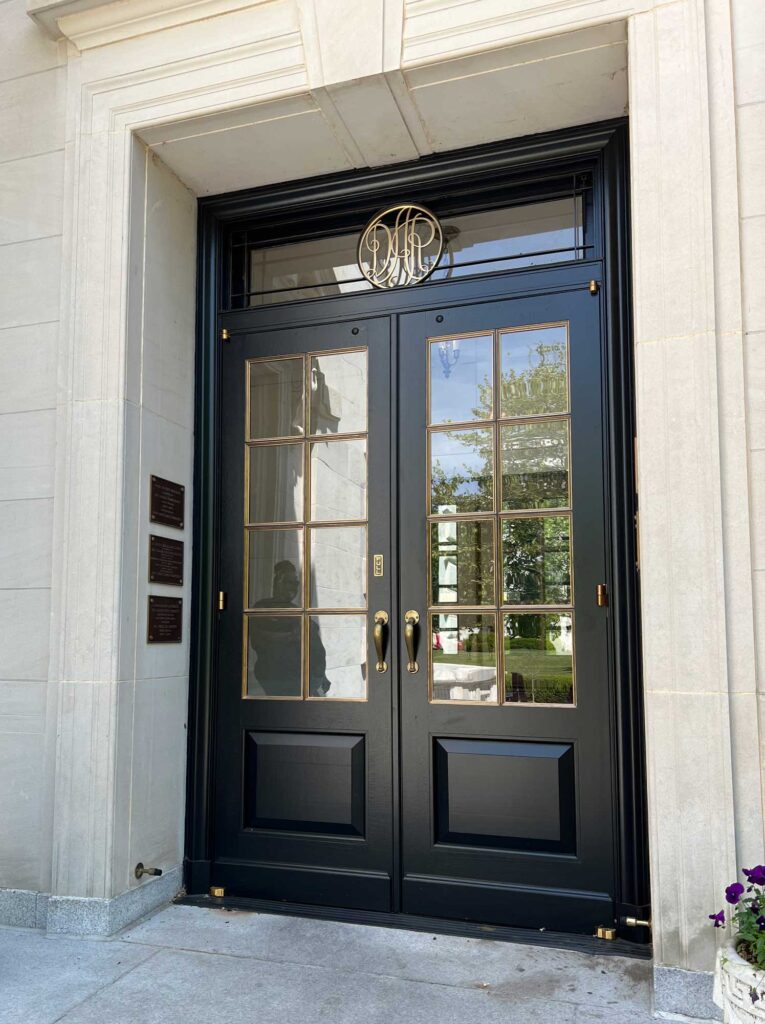
Gifts and Sponsorships
Contributions to the President General’s project to restore and conserve Memorial Continental Hall, a living monument to the Society’s Patriot ancestors, are critically important as the nation prepares for the Semiquincentennial (250th) celebration. Donations ensure that all the essential renovation work to the Crown Jewel of the DAR’s Historic complex of buildings, provides a secure home to the precious objects and artifacts entrusted to the Society’s care.
Gifts at all levels and sponsorship include the President General’s Project donors, the Stars & Stripes Giving Circle donors, and the Old Glory Giving Circle donors ($1,250 – $4,999, approx. 1000). They represent all Daughters past and present, the more than 1,065,000 members since DAR’s founding.
Sponsorship opportunities were created in recognition of distinguished Daughters throughout the organization’s history, who have nurtured and sustained the Society since its founding.
Beginning with founder, Eugenia Washington, ($5,000 – $9,999, approx. 61), National #1. She advocated for DAR to be a patriotic organization founded on a Patriot’s service.
The next sponsorship level ($10,000 – $24,000, approx. 28) recognizes founder, Mary Desha, National #4. She vowed in the earliest planning stages of the National Society, “I am good for any amount of work.”
The next sponsorship level ($25,000 – $49,000, approx. 6) is bestowed upon founder Ellen Harding Walworth, National #5. She declared herself in support of “the advancement of women and “always a Suffragist.”
Mary Virginia Ellet Cabell, National #6, and President Presiding. This sponsorship level ($50,000 – $74,999, approx. 5) recognizes the distinguished woman responsible for proposing during the first Continental Congress: “…..As an outward and visible sign of an inward and spiritual grace, the building of a House Beautiful…the finest building ever owned by women…an enterprise which men and women will arise and call blessed because of its wide and spreading influence and the magnificent possibilities it offers to our sisterhood, the patriotic, home-loving and country-loving women of America.”
Caroline Scott Harrison, National #7, and the First President General, 1890-1892. Sponsorship level ($75,000 – $99,999, approx. 1), recognizes the First Lady of the United States, who was deeply committed to historic preservation. She was known to have rallied Daughters to come together and do what was necessary to protect our home, our treasures and our stories for generations to come.
Founder, Mary Smith Lockwood, National #27 represents sponsorship level ($100,000 – $149,000, approx. 2). The movement to build Memorial Continental Hall resulted from her commitment to historic preservation, inspiring the National Society to adopt a resolution on October 18, 1890, to “provide a place for the collection of Historical relics which will accumulate…and for historical portraits, pictures, etc. This may first be in rooms, and later in the erection of a fire-proof building.”
President General 1905-1909, Emily Nelson Ritchie McLean, National #269, represents sponsorship level ($150,000 – $249,000, approx. 1). The Memorial Continental Hall Committee rejuvenated interest in the project by instituting a program in which donations paid for specific features of the building. The result was a bank loan in the amount of $200,000.
President General 1913-1917, Daisy Allen Story, National #826, represents sponsorship level ($250,000 – $499,000). The final contribution to the debt was made by Ellen Washington Bellamy during the Story Administration. Mrs. Story hosted the National Society’s Silver Jubilee in Memorial Continental Hall.
President General 1909-1913, Julia Green Scott, National #4982, represents sponsorship level ($500,000 – $999,000). The Scott Administration raised $100,000 towards paying off the debt, furnished the rooms and organized the final move into Memorial Continental Hall.
President General 1901-1905, Cornelia Cole Fairbanks, National #9558, represents sponsorship level ($1,000,000). Before leaving office in 1905, she presided over Continental Congress in a new building owned exclusively by NSDAR: Memorial Continental Hall. Although the Hall would not be completed for several more years, she had overseen the purchase of land, the choice of architect and design, and the first stages of construction.

Acknowledgements
President General Pamela Rouse Wright
2022-2025
Suzanne M. Heske
Historian General, 2022 – 2025, Author and Creator
Joy O’Donnell
NSDAR Archives
Patrick Sheary
Curator of Furnishing and Historic Preservation, Museum
DAR Office of Development
Amanda DeFrancesco
Assistant Director, Communications
Octavo Designs
Design and Development
Lanabeth Horgen
Recording Secretary General, Editor
Nancy Shirm Wright
Organizing Secretary General, Editor

Photo Acknowledgements
NSDAR Archives
Including early photographs of Ernest Crandal
DAR Office of Development
Suzanne M. Heske
Historian General

Other Credits
Smithsonian Reports
American Monthly Magazine Issues
Handbook of memorial Continental Hall, 1912; Marie Wilkinson Hodges; Published by “Press of Byron S. Adams,” Washington, DC.
A Century of Service: The Story of the DAR, 1991; Ann Arnold Hunter; Published by National Society Daughters of the American Revolution.
American Treasure: The Enduring Spirit of the DAR, 2007; Diana L. Bailey; Published by “The Donning Company Publishers,” Virginia Beach, VA.
Memorial Continental Hall: 100 Years of History, Museum Exhibit, National Society Daughters of the American Revolution.
This timely restoration constitutes the largest portion of the Wright Administration’s President General’s Project and ensures the long-term preservation of our House Beautiful. I thank you, the Daughters, for making this extensive restoration possible. As your President General, I honor your commitment and generosity to this project.
I hope as you view this exhibit and walk the Halls of Memorial Continental Hall, you will take note of what has been accomplished. As with any restoration of a historic property it is more than paint and polish. We have taken this historic building to the studs and brought it back to life for another Century of Service.
With dedication and commitment, we will keep this cherished site as an enduring monument to our Patriots’ ancestors.
Pamela Edwards Rouse Wright
President General, 2022–2025



